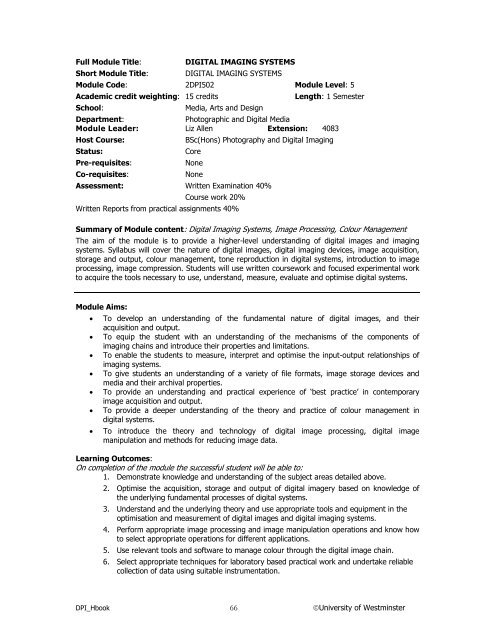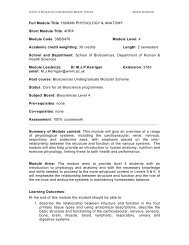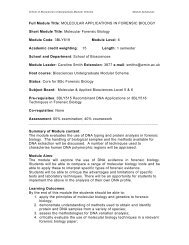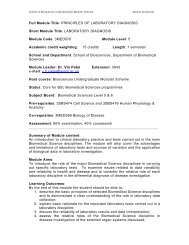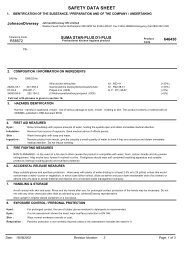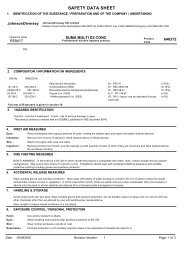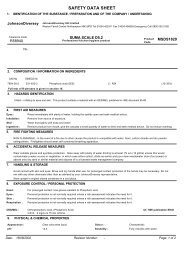CONTENTS 1. Introduction 1.1 Course Outline 1 1.2 Introduction ...
CONTENTS 1. Introduction 1.1 Course Outline 1 1.2 Introduction ...
CONTENTS 1. Introduction 1.1 Course Outline 1 1.2 Introduction ...
You also want an ePaper? Increase the reach of your titles
YUMPU automatically turns print PDFs into web optimized ePapers that Google loves.
Full Module Title:<br />
DIGITAL IMAGING SYSTEMS<br />
Short Module Title: DIGITAL IMAGING SYSTEMS<br />
Module Code: 2DPI502 Module Level: 5<br />
Academic credit weighting: 15 credits<br />
Length: 1 Semester<br />
School:<br />
Media, Arts and Design<br />
Department:<br />
Photographic and Digital Media<br />
Module Leader: Liz Allen Extension: 4083<br />
Host <strong>Course</strong>:<br />
BSc(Hons) Photography and Digital Imaging<br />
Status:<br />
Core<br />
Pre-requisites:<br />
None<br />
Co-requisites:<br />
None<br />
Assessment: Written Examination 40%<br />
<strong>Course</strong> work 20%<br />
Written Reports from practical assignments 40%<br />
Summary of Module content: Digital Imaging Systems, Image Processing, Colour Management<br />
The aim of the module is to provide a higher-level understanding of digital images and imaging<br />
systems. Syllabus will cover the nature of digital images, digital imaging devices, image acquisition,<br />
storage and output, colour management, tone reproduction in digital systems, introduction to image<br />
processing, image compression. Students will use written coursework and focused experimental work<br />
to acquire the tools necessary to use, understand, measure, evaluate and optimise digital systems.<br />
Module Aims:<br />
• To develop an understanding of the fundamental nature of digital images, and their<br />
acquisition and output.<br />
• To equip the student with an understanding of the mechanisms of the components of<br />
imaging chains and introduce their properties and limitations.<br />
• To enable the students to measure, interpret and optimise the input-output relationships of<br />
imaging systems.<br />
• To give students an understanding of a variety of file formats, image storage devices and<br />
media and their archival properties.<br />
• To provide an understanding and practical experience of ‘best practice’ in contemporary<br />
image acquisition and output.<br />
• To provide a deeper understanding of the theory and practice of colour management in<br />
digital systems.<br />
• To introduce the theory and technology of digital image processing, digital image<br />
manipulation and methods for reducing image data.<br />
Learning Outcomes:<br />
On completion of the module the successful student will be able to:<br />
<strong>1.</strong> Demonstrate knowledge and understanding of the subject areas detailed above.<br />
2. Optimise the acquisition, storage and output of digital imagery based on knowledge of<br />
the underlying fundamental processes of digital systems.<br />
3. Understand and the underlying theory and use appropriate tools and equipment in the<br />
optimisation and measurement of digital images and digital imaging systems.<br />
4. Perform appropriate image processing and image manipulation operations and know how<br />
to select appropriate operations for different applications.<br />
5. Use relevant tools and software to manage colour through the digital image chain.<br />
6. Select appropriate techniques for laboratory based practical work and undertake reliable<br />
collection of data using suitable instrumentation.<br />
DPI_Hbook 66 ©University of Westminster


